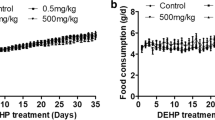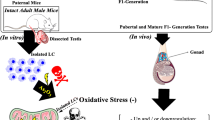Abstract
It was reported that 2,4-dichlorophenoxyacetic acid (2,4-D), a commonly used herbicide and a possible endocrine disruptor, can disturb spermatogenesis, but the precise mechanism is not understood. Since 2,4-D is a weak peroxisome proliferator in hepatocytes and peroxisome proliferator-activated receptor α (PPARα) is also expressed in Leydig cells, this study aimed to investigate the link between PPARα and 2,4-D-mediated testicular dysfunction. 2,4-D (130 mg/kg/day) was administered to wild-type and Ppara-null mice for 2 weeks, and the alterations in testis and testosterone/cholesterol metabolism in Leydig cells were examined. Treatment with 2,4-D markedly decreased testicular testosterone in wild-type mice, leading to degeneration of spermatocytes and Sertoli cells. The 2,4-D decreased cholesterol levels in Leydig cells of wild-type mice through down-regulating the expression of 3-hydroxy-3-methylglutaryl coenzyme A synthase 1 and reductase, involved in de novo cholesterogenesis. However, the mRNAs encoding the important proteins involved in testosterone synthesis were unchanged by 2,4-D except for CYP17A1, indicating that exhausted cholesterol levels in the cells is a main reason for reduced testicular testosterone. Additionally, pregnancy rate and the number of pups between 2,4-D-treated wild-type male mice and untreated female mice were significantly lower compared with those between untreated couples. These phenomena were not observed in 2,4-D-treated Ppara-null males. Collectively, these results suggest a critical role for PPARα in 2,4-D-induced testicular toxicity due to disruption of cholesterol/testosterone homeostasis in Leydig cells. This study yields novel insights into the possible mechanism of testicular dysfunction and male infertility caused by 2,4-D.








Similar content being viewed by others
Abbreviations
- 2,4-D:
-
2,4-Dichlorophenoxyacetic acid
- PPARα:
-
Peroxisome proliferator-activated receptor α
- HMG-CoA:
-
3-Hydroxy-3-methylglutaryl coenzyme A
- PBS:
-
Phosphate-buffered saline
- DAB:
-
3,3′-Diaminobenzidine
- BSA:
-
Bovine serum albumin
- EBSS:
-
Earle’s balanced salt solution
- qPCR:
-
Quantitative polymerase chain reaction
- LH:
-
Luteinizing hormone
- SD:
-
Standard deviation
- CYP:
-
Cytochrome P450
- DEHP:
-
Di-2-ethylhexyl phthalate
References
Abdellatif AG, Préat V, Vamecq J, Nilsson R, Roberfroid M (1990) Peroxisome proliferation and modulation of rat liver carcinogenesis by 2,4-dichlorophenoxyacetic acid, 2,4,5-trichlorophenoxyacetic acid, perfluorooctanoic acid and nafenopin. Carcinogenesis 11:1899–1902
Amer SM, Aly FA (2001) Genotoxic effect of 2,4-dichlorophenoxy acetic acid and its metabolite 2,4-dichlorophenol in mouse. Mutat Res 494:1–12
Aoyama T, Yamano S, Waxman DJ, Lapenson DP, Meyer UA, Fischer V, Tyndale R, Inaba T, Kalow W, Gelboin HV et al (1989) Cytochrome P-450 hPCN3, a novel cytochrome P-450 IIIA gene product that is differentially expressed in adult human liver. cDNA and deduced amino acid sequence and distinct specificities of cDNA-expressed hPCN1 and hPCN3 for the metabolism of steroid hormones and cyclosporine. J Biol Chem 264:10388–10395
Aoyama T, Peters JM, Iritani N, Nakajima T, Furihata K, Hashimoto T, Gonzalez FJ (1998) Altered constitutive expression of fatty acid-metabolizing enzymes in mice lacking the peroxisome proliferator-activated receptor alpha (PPARalpha). J Biol Chem 273:5678–5684
Biegel LB, Hurtt ME, Frame SR, O’Connor JC, Cook JC (2001) Mechanisms of extrahepatic tumor induction by peroxisome proliferators in male CD rats. Toxicol Sci 60:44–55
Braissant O, Foufelle F, Scotto C, Dauca M, Wahli W (1996) Differential expression of peroxisome proliferator-activated receptors (PPARs): tissue distribution of PPAR-alpha, -beta, and -gamma in the adult rat. Endocrinology 137:354–366
Charles JM, Cunny HC, Wilson RD, Bus JS (1996) Comparative subchronic studies on 2,4-dichlorophenoxyacetic acid, amine, and ester in rats. Fundam Appl Toxicol 33:161–165
Corton JC, Lapinskas PJ (2005) Peroxisome proliferator-activated receptors: mediators of phthalate ester-induced effects in the male reproductive tract? Toxicol Sci 83:4–17
Desdoits-Lethimonier C, Albert O, Le Bizec B, Perdu E, Zalko D, Courant F, Lesné L, Guillé F, Dejucq-Rainsford N, Jégou B (2012) Human testis steroidogenesis is inhibited by phthalates. Hum Reprod 27:1451–1459
Emeis JJ, Van Gent CM, Van Sabben CM (1977) An enzymatic method for the histochemical localization of free and esterified cholesterol separately. Histochem J 9:197–204
Frantz SW, Kropscott BE (1993) Pharmacokinetic evaluation of a single oral administration of the 2-ethylhexyl (isooctyl) ester of 2,4-D to Fischer 344 rats. J Occup Med Toxicol 2:75–85
Gale JS, Wakefield JS, Ford HC (1982) Isolation of rat Leydig cells by density gradient centrifugation. J Endocrinol 92:293–302
Gazouli M, Yao ZX, Boujrad N, Corton JC, Culty M, Papadopoulos V (2002) Effect of peroxisome proliferators on Leydig cell peripheral-type benzodiazepine receptor gene expression, hormone-stimulated cholesterol transport, and steroidogenesis: role of the peroxisome proliferator-activator receptor alpha. Endocrinology 143:2571–2583
Kamijo Y, Hora K, Tanaka N, Usuda N, Kiyosawa K, Nakajima T, Gonzalez FJ, Aoyama T (2002) Identification of functions of peroxisome proliferator-activated receptor alpha in proximal tubules. J Am Soc Nephrol 13:1691–1702
Kawashima Y, Katoh H, Nakajima S, Kozuka H, Uchiyama M (1984) Effects of 2,4-dichlorophenoxyacetic acid and 2,4,5-trichlorophenoxyacetic acid on peroxisomal enzymes in rat liver. Biochem Pharmacol 33:241–245
Kumar P, Prasad AK, Dutta KK (2000) Steroidogenic alterations in testes and sera of rats exposed to trichloroethylene (TCE) by inhalation. Hum Exp Toxicol 19:117–121
Lapinskas PJ, Brown S, Leesnitzer LM, Blanchard S, Swanson C, Cattley RC, Corton JC (2005) Role of PPARalpha in mediating the effects of phthalates and metabolites in the liver. Toxicology 207:149–163
Lee SS, Pineau T, Drago J, Lee EJ, Owens JW, Kroetz DL, Fernandez-Salguero PM, Westphal H, Gonzalez FJ (1995) Targeted disruption of the alpha isoform of the peroxisome proliferator-activated receptor gene in mice results in abolishment of the pleiotropic effects of peroxisome proliferators. Mol Cell Biol 15:3012–3022
Lerda D, Rizzi R (1991) Study of reproductive function in persons occupationally exposed to 2,4-dichlorophenoxyacetic acid (2,4-D). Mutat Res 262:47–50
Maqdasy S, Baptissart M, Vega A, Baron S, Lobaccaro JM, Volle DH (2013) Cholesterol and male fertility: what about orphans and adopted? Mol Cell Endocrinol 368:30–46
Mattsson JL, Charles JM, Yano BL, Cunny HC, Wilson RD, Bus JS (1997) Single-dose and chronic dietary neurotoxicity screening studies on 2,4-dichlorophenoxyacetic acid in rats. Fundam Appl Toxicol 40:111–119
Mendis-Handagama SM, Zirkin BR, Scallen TJ, Ewing LL (1990) Studies on peroxisomes of the adult rat Leydig cell. J Androl 11:270–278
Mrotek JJ, Mathew JK, Curtis JC, Johansson KR (1981) A method for the isolation of lipid droplet fractions from decapsulated rat adrenals. Steroids 38:229–241
Munro IC, Carlo GL, Orr JC, Sund KG, Wilson RM, Kennepohl E, Lynch BS, Jablinske M (1992) A comprehensive, integrated review and evaluation of scientific evidence relating to the safety of the herbicide 2,4-D. Int J Toxicol 11:559–664
Nakajima T, Tanaka N, Sugiyama E, Kamijo Y, Hara A, Hu R, Li G, Li Y, Nakamura K, Gonzalez FJ, Aoyama T (2008) Cholesterol-lowering effect of bezafibrate is independent of peroxisome proliferator-activated receptor activation in mice. Biochem Pharmacol 76:108–119
Novikoff AB, Goldfischer S (1969) Visualization of peroxisomes (microbodies) and mitochondria with diaminobenzidine. J Histochem Cytochem 17:675–680
Ozaki K, Mahler JF, Haseman JK, Moomaw CR, Nicolette ML, Nyska A (2001) Unique renal tubule changes induced in rats and mice by the peroxisome proliferators 2,4-dichlorophenoxyacetic acid (2,4-D) and WY-14643. Toxicol Pathol 29:440–450
Parks LG, Ostby JS, Lambright CR, Abbott BD, Klinefelter GR, Barlow NJ, Gray LE Jr (2000) The plasticizer diethylhexyl phthalate induces malformations by decreasing fetal testosterone synthesis during sexual differentiation in the male rat. Toxicol Sci 58:339–349
Reddy J, Svoboda D (1972) Microbodies (peroxisomes) in the interstitial cells of rodent testes. Lab Investig 26:657–665
Schultz R, Yan W, Toppari J, Völkl A, Gustafsson JA, Pelto-Huikko M (1999) Expression of peroxisome proliferator-activated receptor alpha messenger ribonucleic acid and protein in human and rat testis. Endocrinology 140:2968–2975
Skinner MK, Norton JN, Mullaney BP, Rosselli M, Whaley PD, Anthony CT (1991) Cell-cell interactions and the regulation of testis function. Ann N Y Acad Sci 637:354–363
Steinberger E, Steinberger A, Vilar O (1966) Cytochemical study of delta-5-3-beta-hydroxysteroid dehydrogenase in testicular cells grown in vitro. Endocrinology 79:406–410
Watanabe K, Fujii H, Takahashi T, Kodama M, Aizawa Y, Ohta Y, Ono T, Hasegawa G, Naito M, Nakajima T, Kamijo Y, Gonzalez FJ, Aoyama T (2000) Constitutive regulation of cardiac fatty acid metabolism through peroxisome proliferator-activated receptor alpha associated with age-dependent cardiac toxicity. J Biol Chem 275:22293–22299
Acknowledgments
The authors thank Drs. Tamie Nakajima, Osamu Yamanoshita, and Minoru Omura for advice in support of this study.
Author information
Authors and Affiliations
Corresponding author
Additional information
Yukiko Harada and Naoki Tanaka have equally contributed to this work.
Electronic supplementary material
Below is the link to the electronic supplementary material.
Rights and permissions
About this article
Cite this article
Harada, Y., Tanaka, N., Ichikawa, M. et al. PPARα-dependent cholesterol/testosterone disruption in Leydig cells mediates 2,4-dichlorophenoxyacetic acid-induced testicular toxicity in mice. Arch Toxicol 90, 3061–3071 (2016). https://doi.org/10.1007/s00204-016-1669-z
Received:
Accepted:
Published:
Issue Date:
DOI: https://doi.org/10.1007/s00204-016-1669-z




